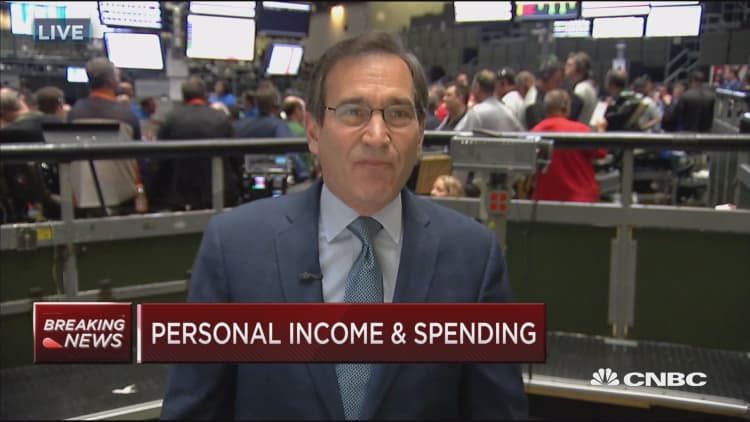Retailers aren't letting a poor start to the year bring them down.
Despite an epidemic of weak first-quarter revenue reports — followed by an anemic start to the current period — several troubled retailers are holding out hope that things will get better in the second half of the year.
At Best Buy, where a lack of major mobile phone rollouts pressured first-quarter sales, managers said they expect revenue to turn positive in the second half, when new products are released. At Abercrombie & Fitch, where sales trends reversed their momentum from the holiday period, the team said it expects comparable sales to remain challenging in the second quarter but improve in the second half. And at Tiffany, the luxury firm's lowered full-year guidance assumes the current quarter will remain tough, but trends will turn for the better in the second half.
Analysts, however, aren't as confident that the second half and holiday season will be merry and bright.
Tuesday delivered another round of data that underscored just how difficult it is to decode consumers' willingness to spend. Shortly after government data showed that consumer spending logged its biggest gain in more than six years in April, a separate report by the Conference Board said consumer confidence slipped 2.1 points to 92.6 percent in May.
Paired with a slow rise in gasoline prices, uncertainty around the presidential election and ongoing turmoil in Europe, analysts are concerned that retailers pinning their hopes on a second-half recovery may be grasping at straws. Adding to their challenges are an over-reliance on discounts and an inability keep inventories lean in a sluggish sales environment.
"[Speaking] broadly, they're not going to see a turnaround in the latter part of the year," said John Squire, CEO of DynamicAction.
Data gathered by Squire's analytics firm indicates retailers are consistently struggling to drum up sales in two major ways. For one, as retailers universally slash prices to lure in shoppers, they're having a tougher time getting those customer to stick around for another purchase. That's because their loyalties tend to ebb and flow with a company's prices.
So far this quarter, retailers' ability to persuade a customer to make a second purchase within three months is down 5 percent on average, according to DynamicAction. At the same time, the firm's data show that new customer acquisition is trending lower, indicating a broader slowdown in consumer spending.
"That's a metric that tells you your business is going to contract," Squire said.
Steve Barr, U.S. retail and consumer sector leader at PwC, said there is no one answer as to whether retailers' second-half hopes are realistic. That's because a company's execution can make a big difference.
Barr added that although several economic fundamentals are growing stronger, upcoming votes on the next U.S. president and Britain's future with the European Union could cause consumers to think twice before they swipe their credit cards. Other challenges include the shift to online shopping and figuring out the right amount of inventory to have on the shelves at the holidays.
"It's a very challenging time to be a retailer," Barr said.
Even some companies that started 2016 strong were reluctant to declare victory. On the heels of PVH's first-quarter earnings beat last week, analysts wondered why the company wasn't more aggressive with its targets. PVH raised its full-year earnings guidance to between $6.45 and $6.55 a share from a previous range of between $6.30 and $6.50.
"In the first quarter, most companies are missing [and] taking down guidance," CEO Emanuel Chirico told analysts. "This doesn't seem like the environment to try and be a hero in."

Yet many management teams were optimistic that their internal initiatives would be enough to get shoppers spending in their stores again. Abercrombie & Fitch told analysts last week that it expects upgrades to its Hollister fleet, along with better product from its new design team, to help lift its results in the second half. Analysts were split on this theory, with some quick to point out that this could be tough given more difficult comparisons.
Tiffany's revised full-year forecast implies that trends will stabilize in the second half — an assumption Credit Suisse analyst Christian Buss called "ambitious" given tepid jewelry demand. Should the brand's sales not improve during the third quarter, Morgan Stanley analyst Kimberly Greenberger cautioned that the brand could be forced to lower its full-year guidance a second time.
For Best Buy, the departure of CFO Sharon McCollam and a soft new product cycle is giving some analysts pause about a second-half acceleration. Citi analyst Kate McShane told investors last month she doesn't expect the chain's domestic comparable sales will show meaningful improvement in the foreseeable future, adding the next generation of iPhones "may not be significant enough to materially move the needle."
To be sure, the first quarter is the smallest three-month sales period for most retailers. The group should also be up against easier comparisons as the year progresses, as late deliveries from last year's port slowdown, along with an unseasonably warm winter, held back results.
Regardless of all these external pushes and pulls, many retailers are choosing to rely on their own execution to drive sales.
"Even though traffic may ebb and flow in the malls ... we continue to increase our conversion with them," Abercrombie & Fitch Executive Chairman Arthur Martinez told analysts last week. "We're focused on what happens in our stores."





